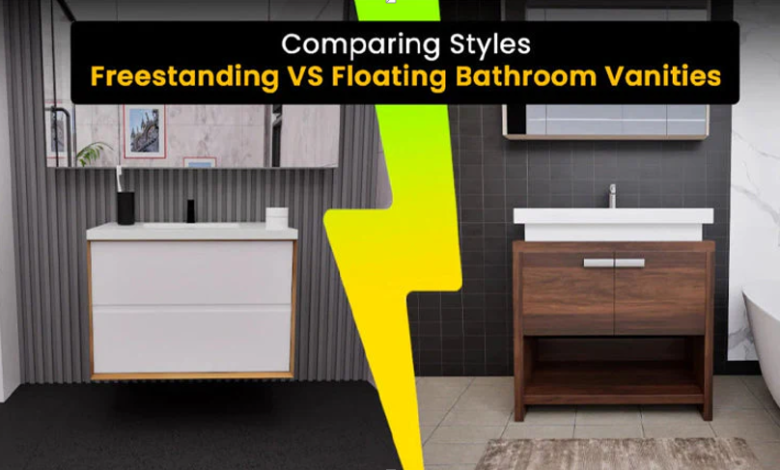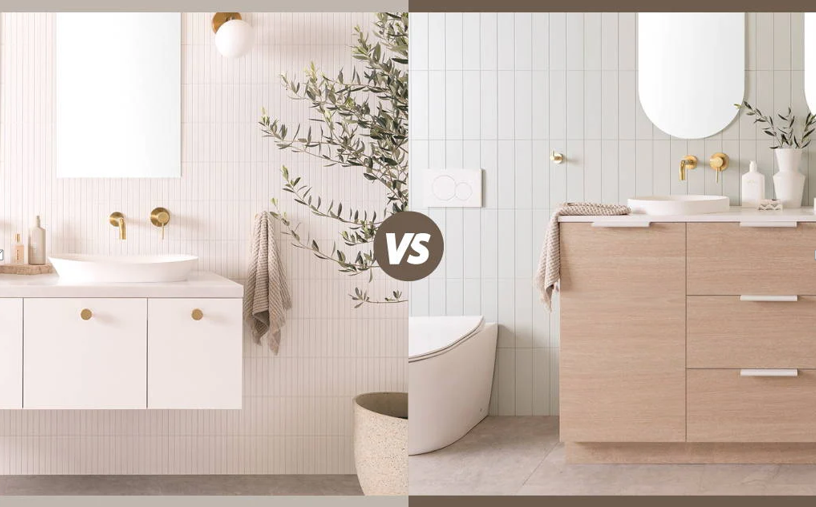Freestanding vs. Wall-Mounted Bathroom Vanities: Which Fits Your Space Best?

A bathroom vanity is the visual centerpiece of any bathroom. Its design sets the tone for the entire space, influencing both style and atmosphere. Among the many vanity styles, freestanding and wall-mounted remain the most debated choices. The freestanding vanity exudes a sense of classic solidity, while the wall-mounted version wins fans with its light, airy minimalism.
From a design perspective, neither is inherently “better”—it’s all about fit. This article breaks down the two styles across four dimensions: spatial perception, style compatibility, aesthetic details, and functional design, helping you find the perfect vanity for your bathroom.
1. Spatial Design: “Grounded Presence” vs. “Floating Expansion”
Your bathroom’s spatial feel is the first thing anyone notices. Freestanding and wall-mounted vanities shape space in very different ways, largely due to whether they touch the floor or appear to float.
Freestanding: Creating a Stable, Grounded Presence
Freestanding vanities consist of a countertop, cabinet, and floor support, forming a solid, anchored visual block. Their advantages include:
- Filling space and balancing proportions: In bathrooms with high ceilings (2.8m+) or large floor areas (8㎡+), a freestanding vanity anchors the space, preventing it from feeling empty or “floating.” For example, a solid wood freestanding vanity in an open-plan master bath visually ties together the bathtub and shower, creating a sense of stability.
- Defining functional zones: Without physical partitions, a freestanding vanity naturally separates the wash area from other zones like the toilet or shower. No extra dividers are needed, making spatial organization clear.
- Compact options for small spaces: Mini freestanding vanities (60–70cm wide) integrate countertop, cabinet, and base into a single vertical structure. This reduces visual clutter and works surprisingly well in narrow bathrooms.
Wall-Mounted: Creating Airiness and Visual Expansion
Wall-mounted vanities are attached to the wall with a floating base, freeing the floor and maximizing perceived space:
- Open floor, extended sightlines: With nothing blocking the floor, the bathroom feels more spacious. This is perfect for small or narrow bathrooms (under 5㎡), where a floating vanity can make the space feel up to 10% larger.
- Minimalist aesthetics: Thin, legless cabinets blend seamlessly with the wall. In an all-white minimalist bathroom, a thin wall-mounted vanity with a sleek countertop almost disappears, leaving only clean lines.
- Adapting to irregular spaces: For bathrooms with sloped ceilings or exposed pipes, a custom wall-mounted vanity can fit precisely, preserving both function and aesthetics—something freestanding vanities struggle with.
See also: The Difference Between Aged Care Homes and Nursing Homes
2. Style Compatibility: “Versatile” vs. “Focused”
A vanity must synchronize with the bathroom’s style. Freestanding and wall-mounted vanities differ in how broadly they adapt:
Freestanding: Universally Adaptable
Thanks to their full-bodied design, freestanding vanities can blend into a variety of styles:
- Vintage / New Chinese Style: Wood cabinets (walnut, cherry) with marble countertops and brass faucets create a warm, elegant vintage feel. Grid-style cabinet doors and ink-patterned engineered stone countertops suit modern interpretations of traditional Chinese design.
- Industrial: Concrete countertops, iron frames, and black metal cabinets with open shelving highlight a rough, industrial aesthetic.
- French Country / Cottage: White wood cabinets with rounded edges, ceramic basins, brass hardware, and floral lighting achieve a romantic or pastoral vibe.
Advantage: You can adjust materials, colors, and decorative details to match nearly any style.
Wall-Mounted: Targeted for Modern Minimalism
Floating vanities’ clean lines and light forms make them ideal for contemporary styles:
- Minimalist / Wabi-Sabi: Handleless cabinets with thin stone countertops in white, light gray, or cement tones, paired with frameless mirrors, create restrained elegance. For wabi-sabi, microcement countertops and weathered wood add warmth.
- Scandinavian / Japanese: Light wood cabinets with white ceramic basins and semi-open shelving highlight natural simplicity. Adding woven storage baskets or linen racks complements the style.
- Industrial / Dark: Black metal frames with black stone countertops, floating drawers, and exposed piping reinforce a stark industrial or moody look.
Limitation: Wall-mounted vanities rarely suit vintage or heavily ornate European styles—they can feel visually “light” and out of place.

3. Aesthetic Details: “Layered Texture” vs. “Pure Lines”
Fine design lives in the details. Freestanding and wall-mounted vanities showcase two contrasting aesthetics:
Freestanding: Layered, Textured Design
- Countertop and cabinet contrast: Marble with wood cabinets creates tactile contrast; under-mount sinks add visual depth.
- Decorative supports: Traditional legged designs can feature carvings or geometric metal frames.
- Accessory integration: Freestanding vanities accommodate floor mirrors, side shelves, or woven baskets, adding dimension and richness.
Wall-Mounted: Minimalist and Linear
- Seamless countertops: Stone countertops and sinks merge into one smooth surface.
- Hidden hardware: Push-to-open drawers and wall-mounted faucets reduce visual clutter.
- Monochromatic integration: Matching cabinet, countertop, and wall colors make the vanity appear as a continuous part of the wall, emphasizing simplicity.
4. Function vs. Design: “Utility-First” vs. “Design-First”
Functionality is key to good design, and each vanity type balances design and usability differently:
Freestanding: Maximum Storage and Flexibility
- Varied storage: Drawers, cabinets, and open shelving accommodate toiletries, tools, and more.
- Complex plumbing: Cabinets can fully enclose exposed pipes, with hidden access panels for maintenance, blending function and aesthetics.
Wall-Mounted: Sleek but Limited
- Lightweight storage: Shallow drawers or semi-open shelves provide basic storage while maintaining airiness.
- Plumbing integration: Exposed pipes can be painted or designed as decorative elements.
- Structural support: Hidden fasteners and reinforced wall anchors maintain stability without compromising the floating effect.
5. Choosing the Right Vanity for Your Bathroom
Choose freestanding if:
- Large bathroom (6㎡+) or high ceilings (2.7m+).
- Classic, vintage, or eclectic style.
- High storage needs.
- Exposed plumbing or insufficient wall support.
Choose wall-mounted if:
- Small or narrow bathroom (<5㎡).
- Modern, minimalist, Scandinavian, wabi-sabi, or industrial style.
- Ease of cleaning and floor accessibility is important.
- Solid walls for secure installation.
Conclusion
Freestanding vanities are inclusive, supporting diverse needs with solid structure. Wall-mounted vanities are focused, emphasizing minimalist elegance and floating aesthetics.
There’s no single “best” choice. Consider your bathroom’s space, style, and functional needs. A well-chosen vanity that blends with your space and daily habits is the perfect fit.

